Top 10 Patterns from Lake Cumberland
Largemouths and smallmouths shared the spotlight in Kentucky
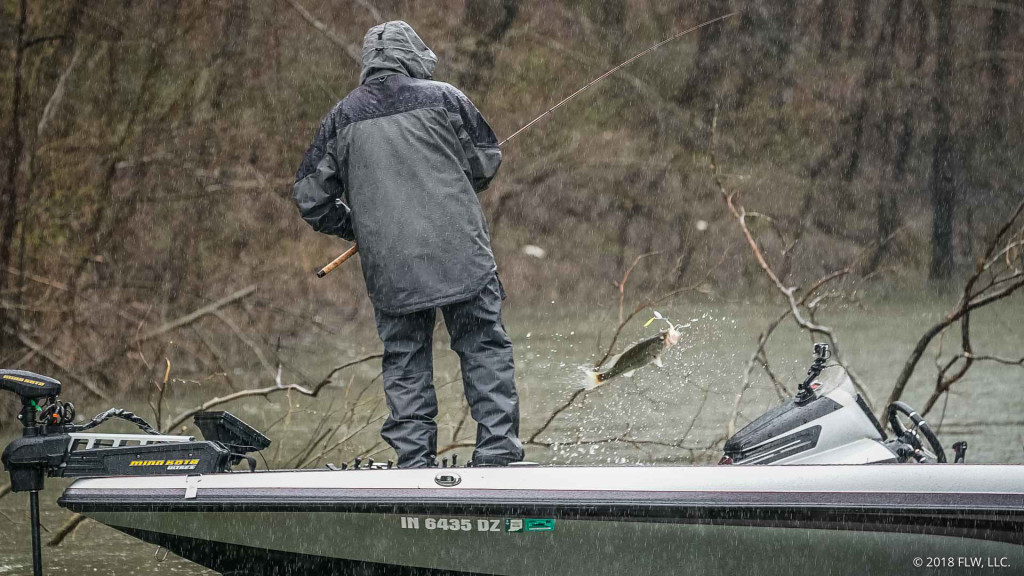
The debate over whether to target smallmouths or largemouths really didn’t matter too much at the FLW Tour event presented by General Tire on Lake Cumberland. Both were eating all throughout the tournament, and weights were mostly comparable. In some areas, they were even mixed together, though the top two finishers elected to run patterns that were exclusive to one species or the other.
Cumberland’s lower end was by far the most popular destination of the top-finishing pros. The entire top 10 fished from the middle of the lake down to the dam.
Weather conditions were highly variable throughout practice and the tournament. Extreme cold during practice was a downer for creature comfort, but the first two days of competition were warm and sunny, with heavy winds. Day three was windy, too, but with overcast skies and heavy rain. A gradual temperature drop accompanied by rain all day made for a chilly soaker on Sunday.
Other factors of importance were the water level and clarity. Cumberland was high all week, with plenty of water in the trees to fish, but it was gradually falling until Sunday, when the rains caught up and raised the elevation slightly. Clarity was lower than is typical for Cumberland, but not muddy – perfect water for power-fishing.
Most of the pros fished spinnerbaits for largemouths or a mixed bag and swimbaits for smallmouths. Bryan Thrift was in the latter camp and used a couple of small swimbaits to win his sixth FLW Tour event with four daily limits of smallmouths. Here’s how the rest of the finalists earned their checks in Kentucky.
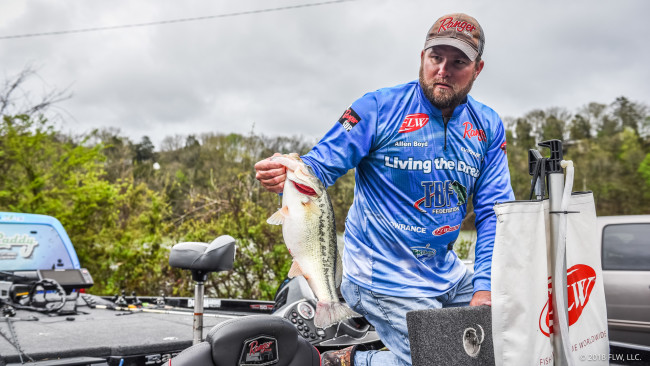
2. Allen Boyd – Salem, Ind. – 68-8
The Bass Federation champ Allen Boyd appeared to be getting stronger as the tournament went on, but misfortune got the best of him on the final day. Boyd suffered a breakdown on the way down the lake Sunday morning and lost a couple hours switching boats. He says he just ran out of time to catch Thrift.
Boyd targeted largemouths in Wolf Creek. Most of his fish came around buck brush. He fished a 3/8-ounce Dirty Jigs Swim Jig with a Strike King Rage Craw trailer with its pincers dyed chartreuse around any wood that he couldn’t get into with a spinnerbait. His two spinnerbaits were both 1/2-ounce models with white and chartreuse skirts with a white front blade and chartreuse back blade. One was by War Eagle; the other BOOYAH.
His plan coming into the tournament was to never fish the same area twice. That changed once he realized the potential in Wolf Creek.
“These two particular pockets I was fishing in Wolf kept spitting out fish,” he says. “When that happens, you’ve got to keep fishing those spots.
“I stayed in those two creeks all day [Sunday] until the end of the day, when I made a last-ditch effort.”
The late switch worked. Boyd stuck a 5-pounder up real shallow to nearly knot it all up with Thrift, who countered with a late-day kicker of his own to ultimately hold off Boyd’s charge.
The creeks in Wolf fit a pattern that Boyd uncovered in practice.
“I was using my Lowrance in practice, looking at my maps and looking for flatter pockets,” he says. “Some I fished and got bit in. Others I just looked at. If I saw a lot of bait in the pocket I knew it would have fish in it.”
The fish gradually crept up shallower as the tournament progressed, to the point that Boyd was fishing right against the bank where, on Saturday, he spotted some muddy spots that told him the largemouths were starting to make beds. All but one of his fish – a big girl that bit right at the boat in front of the FLW Live camera – were caught off the shoreline.
The “muddy spot” clue on Saturday told him he was on the right track to land some giant bass. He did lose a few due to the situation, however.
“They’re ready to spawn, and when they get in that mode they like to smack the bait,” he says. “There was a lot of that today [Sunday].”
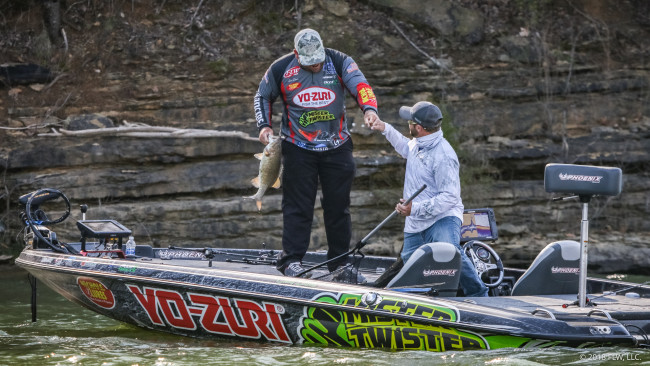
3. Clent Davis – Montevallo, Ala. – 67-10
Twenty smallmouths totaling 67 pounds, 10 ounces took a ride to weigh-in with Clent Davis, who did all his work with a 5-inch hollow, paddle-tail swimbait rigged on a 1/2-ounce homemade jighead.
“I picked up a topwater for a few minutes today [Sunday],” Davis says. “That didn’t work out, so I went back to it.
“All I’ve been fishing all week is points and the insides of points. I’ve been sitting way off of them. Some of my fish were males that I caught up close to the bank, but the majority were females that were suspended. A lot of them would eat it about halfway back to the boat.”
Davis says the water cleared up enough from the pre-practice cutoff to the tournament that it caused his fish to suspend up in the water column, which is why he chose the swimbait.
He pounded on the fish the first couple days in Difficulty Creek. By day three, the spot had dried up, and he had to run to some other areas with similar features.
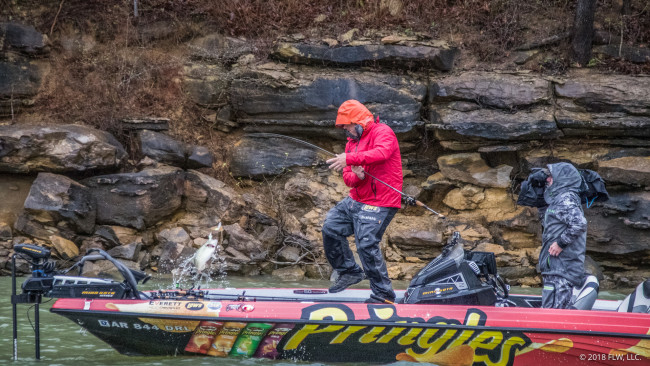
4. Greg Bohannan – Bentonville, Ark. – 65-9
All week long, Greg Bohannan talked about how Cumberland was fishing like an Ozark lake, which fits his style just right.
He was able to work a handful of Ozark-like patterns to earn a fourth-place finish.
On the first day, Bohannan fished a Skirmish Baits AIM-9 jerkbait.
“I was a fishing a little more main lake, trying to catch smallmouths,” he says. “The first day I had one fish at noon. I ended up going in the backs of pockets and keying on largemouths.”
The location switch warranted a bait switch, too, and Bohannan picked up a 3/4-ounce War Eagle spinnerbait with a chartreuse skirt and painted white and chartreuse willow blades. The heavy spinnerbait was a good choice for efficiency.
“I could throw it around bushes and be OK, but when I got out around smallmouths I could slow-roll it without changing baits.”
On day three, he got a few fish to roll on a floating worm, which prompted him to investigate the topwater pattern on the final day with a buzzbait. Neither really heated up for him, and the spinnerbait was the main player.
“I was keying on the back third of pockets,” says Bohannan, who spent much of his time around Beaver Creek. “I tried to get in creeks with a lot of arms, where I could stay in a general area and fish a lot of pockets.”
Unfortunately, Bohannan found his best pockets blown out by run-in on Sunday. He caught a limit on the blade but not of any size and had to back out to smallmouth water. Four smallies ended up in his bag at the final weigh-in.
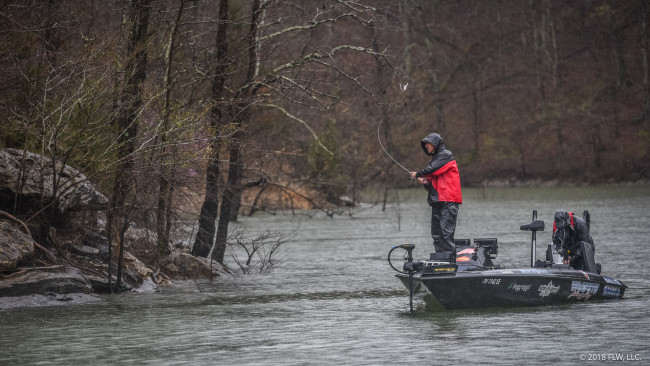
5. Andy Morgan – Dayton, Tenn. – 65-4
Andy Morgan might not have been able to convert his lead on days one and two into a win, but he definitely righted the ship in what has been a tough season for him.
Morgan fished a pattern that suits him perfectly. He stayed on the lower end of Cumberland, mostly in Indian Creek, and caught most of his fish with a 3/4-ounce War Eagle spinnerbait with two white willow blades and a chartreuse and white skirt. He also caught a few fish on a jig, which he thought would be more of a player as the fish started to spawn, but it never produced the same quality of bites as the blade, and flipping consumed more time than he liked.
Most of Morgan’s fish were caught around buck brush, where they were suspended. The rest were caught around flooded sycamore trees or on stretches of bank in between targets. Deflecting the blade off the branches triggered many of his bites.
Largemouths anchored Morgan’s limits. Though he did catch a fair number of smallmouths and spotted bass, too, only a few brown bass went to weigh-in.
On Sunday, Morgan fished a lot of new water but only weighed in 14 pounds, 3 ounces, which was his lightest limit of the tournament. He says his fish moved shallower each day.
“I caught a lot today [Sunday], but they were all the same size. They were all males,” he says. “I’m sure in that area I was fishing they started spawning. I just never could find where those females were. They moved up awfully quick. It’s mid-April. They want to be there.”
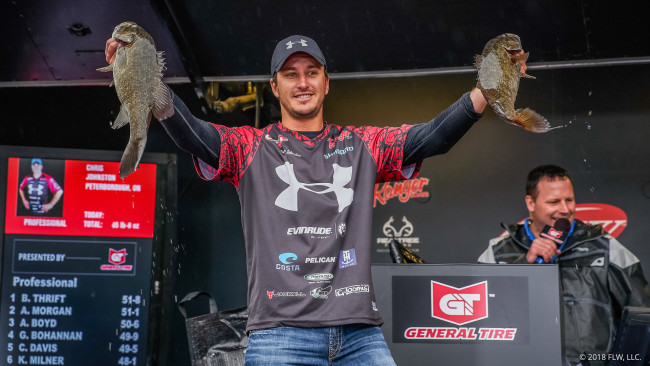
6. Chris Johnston – Peterborough, Ontario – 63-1
Ontario pro Chris Johnston caught a pretty even mix of largemouths and smallmouths en route to his top-10 finish. He didn’t need two patterns, however, because his fish were mixed in together.
“I caught every one but one on a spinnerbait, and I put a Jackall Rhythm Wave 3.8 on the end of it,” he says.
His spinnerbait was white with double willow-leaf blades.
“I put that swimbait on at the end of day one. I had a lot of fish knocking it before that, and it didn’t make a big difference, but I got a few more bites.”
Johnston says he threw his spinnerbait around every piece of wood he could find in one primary area, working progressively shallower each day. Both species were starting to spawn in his best areas. Finding a lot of shad in the creeks was also key.
“If they weren’t spawning, they were up shallow eating shad,” he adds.
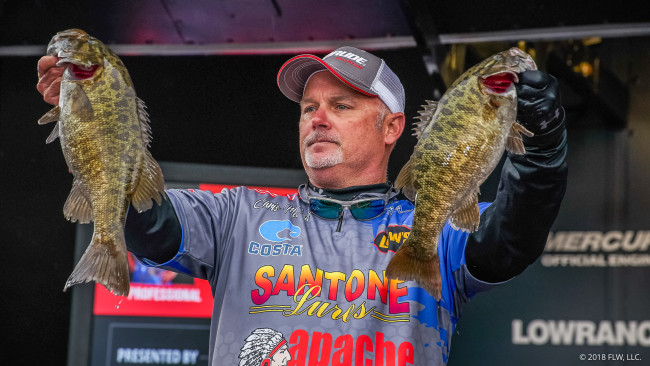
7. Chris McCall – Palmer, Texas – 62-11
Spinnerbait fishing puts Chris McCall in his comfort zone, and he made his second consecutive top 10 at Cumberland with a blade in his hand.
McCall fished a 3/4-ounce Santone model with a white and chartreuse skirt and painted blades. The heavy bait helped him get in the strike zone.
“They’re not up in the water column; they’re down, so I’ve been slow-rolling all week 3 to 4 feet down,” he says.
Targeting rock outcroppings and shelves produced some of McCall’s bites as he worked a series of creeks in the lower end of the lake. His bite gradually transitioned over from largemouths to smallmouths. His limits included five largemouths on day one, three largemouths on day two, four smallmouths on day three and five smallmouths on day four.
“As soon as it got cloudy, I started targeting smallmouths because the largemouths weren’t strong for me,” McCall says.
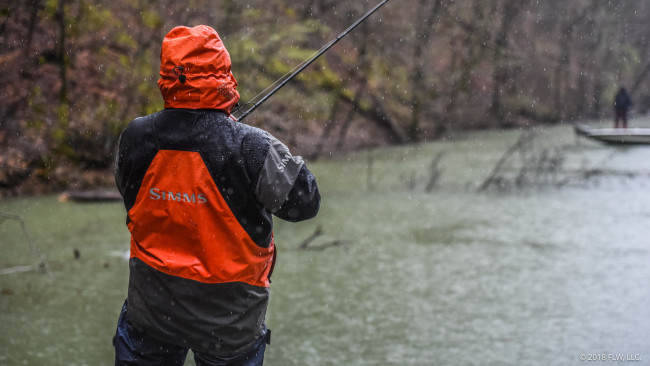
8. James Watson – Lampe, Mo. – 62-2
James Watson weighed in a mixed bag of largemouths and smallmouths from Cumberland’s lower end. He fished a double-willow Luck-E-Strike Jimmy Houston Legends spinnerbait to catch about half his bass the first two days and followed up with a War Eagle double-Colorado model with a Luck-E-Strike Luck-E-Swim trailer.
“The key was just getting on the bank and covering as much water as I could possibly cover,” he says. “I was just slow-rolling that spinnerbait. I did not catch a fish in the back of a pocket until Friday. Every day was an adjustment.
“I couldn’t get bit in the very back today [Sunday]. I thought that run-in [runoff from the rain] would help, but it did nothing for me.”
Watson was also careful to not re-fish water from previous days. He even changed the GPS track lines on his Lowrance unit each day to make it easier to see where he’d been.
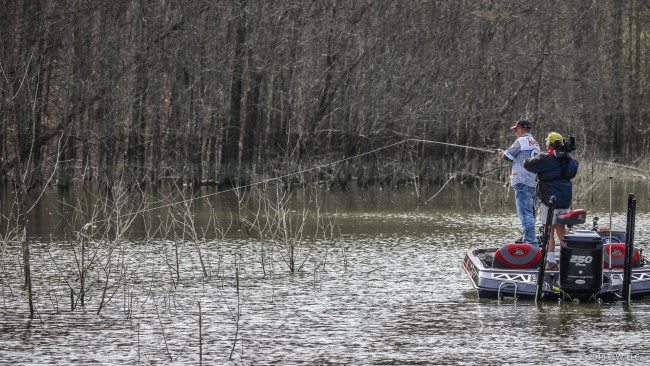
9. Darrel Robertson – Jay, Okla. – 61-14
Former Forrest Wood Cup champ Darrel Robertson banked on a spinnerbait that was a little different to catch most of his fish. It was a 1/2-ounce BOOYAH model with a chartreuse and white skirt, but he swapped out the blades, opting for a turtle shell blade on top and a Colorado on bottom. Robertson also added a swimbait trailer.
The Oklahoma pro fished two spots in the Wolf Creek area for largemouths.
“Most of them were coming out of 8 feet of water,” he says. “Most of the fish I caught were out of buck brush. But this afternoon [Sunday], most of the fish I caught came off the trees. They were up real shallow to start off, but then they moved out. Then they shut up.”
One of his areas was only 200 yards long. The other was a 50-yard stretch. Both featured a flatter bottom, where he could sit 50 feet off the bank and still be in about 12 feet of water.
“It’s a good place for the fish to find a place to spawn,” he adds.
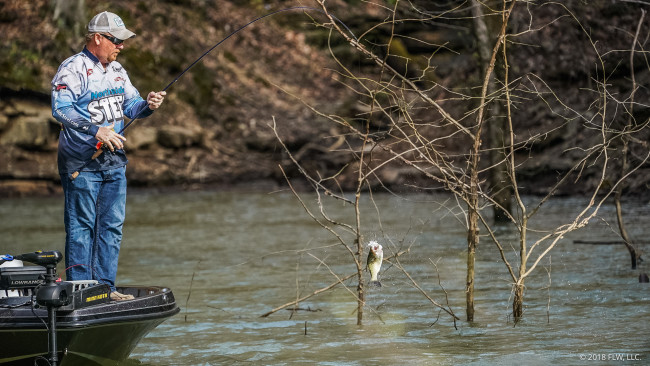
10. Kerry Milner – Bono, Ark. – 60-3
Arkansas pro Kerry Milner describes his approach on Cumberland as nothing fancy. He picked up a 3/4-ounce white or white and chartreuse spinnerbait with a gold willow over a nickel willow and went to work. Milner found a few key spots on the lower end that he fished and re-fished throughout the tournament.
“I was slow-rolling it,” he says of his spinnerbait, “and pretty much just covering water. It wasn’t rocket science.”
The only variation Milner experimented with was to drag a Carolina-rigged Zoom Ultra Vibe Speed Craw for a couple keepers the first day.
“I did not fish any of the big major creek arms,” says Milner, who purposely avoided those areas to get away from fishing pressure. “I fished the little hollows and canyons across from Indian.
“Most all my largemouth bites came around wood in the backs of pockets the first two days,” he adds. “The last two days I backed out to secondary points with rock and caught both species, but mostly smallmouths.”